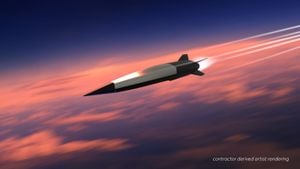Recent advancements in human evolutionary research have unveiled astonishing insights about our ancestral lineage, particularly through the lens of groundbreaking discoveries concerning Denisovans, ancient hominins who coexisted and interbred with early humans. This complex interbreeding has been pivotal not only for our genetic inheritance but also for how modern humans have adapted to various environments.
Scientists have long grappled with the question of how interbreeding has impacted early human history. A review article by Dr. Linda Ongaro from Trinity College Dublin sheds light on the genetic legacies left behind by Denisovans. These hominins, first identified through DNA extracted from fragments, have contributed valuable genes to modern humans, significantly enhancing our adaptation capabilities.
According to the research, Denisovans interbred with early humans multiple times, and this genetic mingling imparted some important traits, allowing modern humans to thrive under diverse biological conditions. For example, genes inherited from Denisovans have been correlated with our ability to adapt to high altitudes, as seen among Tibetan populations, and to extreme cold, which is particularly beneficial for individuals living in the Arctic regions.
The initial rise of interest surrounding Denisovans occurred back in 2010, with the sequencing of the first Denisovan genome from only a finger bone discovered within the Denisova Cave, located in the Altai Mountains of Siberia. This led to the realization of the vast complexity involved with human evolution, moving beyond the simplistic notion of linear ancestry from one common ancestor.
Dr. Ongaro emphasizes the misleading stereotype of human evolution progressing neatly from one stage to another. She notes, “It’s a common misconception,” underscoring the idea of genetic exchange among various hominin groups as “the people we are today.” This complex history drastically shifts the narrative of human evolution away from straightforward origins.
There are still missing pieces to the story, as the fossil record of Denisovans is relatively sparse. Unlike Neanderthals, whose remains are abundant, the recognized evidence for Denisovans includes only the aforementioned finger bone and several dental and cranial fragments. The challenge, then, lies not just in tracking their genes currently present in our genomes but also piecing together their physical existence from this limited material.
With regards to the geographical scope of the Denisovan populations, the research explores how these ancient people possibly adapted to various environments across the globe—from Siberia to Southeast Asia and beyond. There are indications of multiple Denisovan groups, each likely displaying significant genetic diversity due to their adaptations to the distinct ecosystems they inhabited.
Among the genes passed onto modern humans, some particularly stand out: one locus confers tolerance to low oxygen levels, reflecting adaptations necessary for survival at high altitudes. Others relate to immune response and lipid metabolism, which are advantageous for populations inhabiting cooler climates, such as the Inuit. The imprint of Denisovans can be seen as instrumental to how modern humans have navigated diverse ecological challenges.
Further research is imperative; Dr. Ongaro indicates, “There are numerous future directions… to tell a more complete story.” By seeking out understudied populations, researchers aim to unearth more about the traces of Denisovan ancestry, thereby filling the gaps remaining from our evolutionary narrative.
Shifting focus to the broader timeline of human evolution, this exciting discovery fits within a much larger puzzle. The narrative of how humans evolved from their ape-like ancestors to the dynamic beings we are today includes milestones marked by significant fossil findings and genetic analysis.
The drive to understand human evolution gained momentum with hotspots of discovery across Africa, where first impressions of our ancient ancestors were laid bare. Among the most notable early finds was the Taung Child, uncovered by South African mine workers over 100 years ago. At just 2.8 million years old, the find suggested evidence of upright walking among early hominins and set the stage for later groundbreaking revelations.
The narrative took another significant leap with the discovery of Lucy, the Australopithecus afarensis skeleton, unearthed over four decades ago. This pivotal finding illustrated how bipedalism had emerged more than 3 million years ago, propelling scientists to reconsider their models for early human locomotion.
Through the evolution of palaeoanthropology, the conception of our human lineage has shifted dramatically. The past fifty years have witnessed new fossil discoveries and technological advancements, continually reshaping our understandings and debunking myths associated with human evolution.
The transformation from early hominids to modern humans hasn't been linear; rather, it has involved branching pathways influenced by environmental changes, migration, and interspecies interactions. Researchers highlight how species like the Australopithecus and later Homo species began to exhibit traits such as larger brain sizes, tool-making capabilities, and social organization.
This layered history raises intriguing questions about what it truly means to be human. The acceptance of diverse ancestry, inclusive of our Denisovan and Neanderthal relatives, highlights the merging of various lineages—each contributing to the genetic pool we possess today. Such findings pose challenges to conventional definitions of our species and suggest shared traits among disparate hominin groups.
Overall, the story of human evolution is poised to expand as new data emerges. Future discoveries will not only provide insights about our past but will also attempt to unravel the intricacies of human genetics. Ongoing advancements promise to provide clarity about missing links and connections among archaic populations and modern humans.
Revisiting the contributions of Denisovans helps shine light on how interconnected the human story truly is. An examination of the lineage shows evidence of interplay between various hominins paved the way for the adaptive capacities we see among modern humans, enduring as resilient survivors across the globe.



